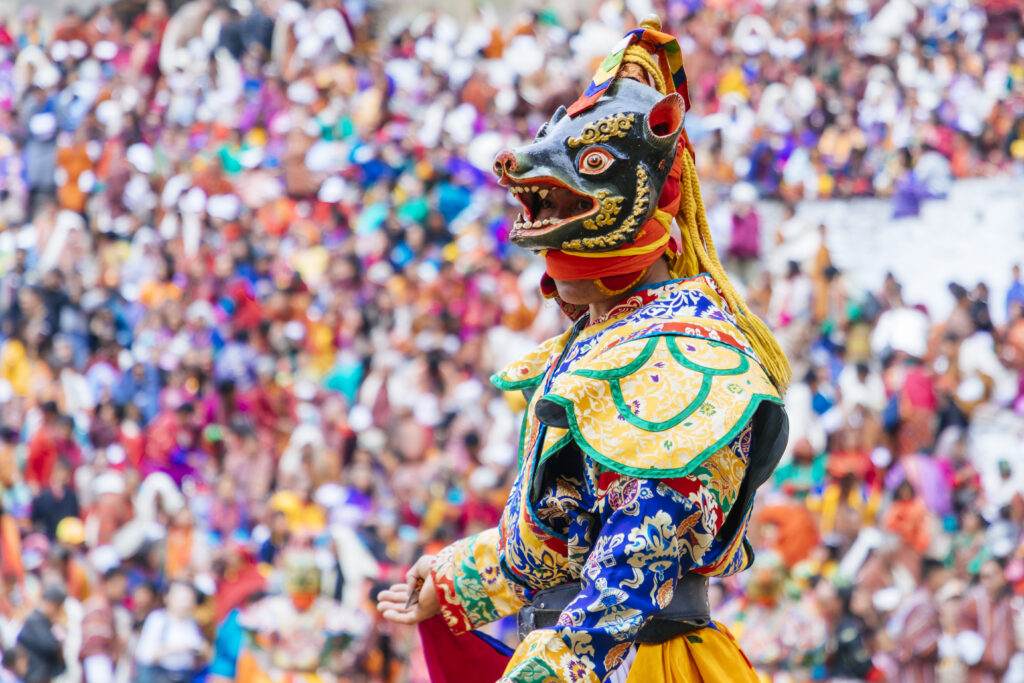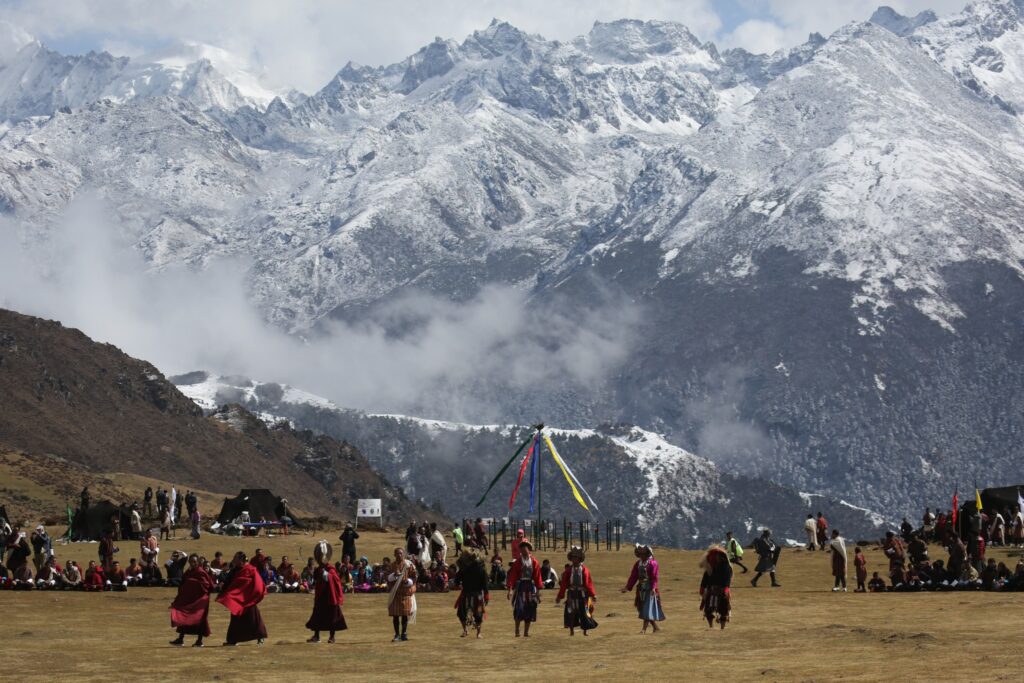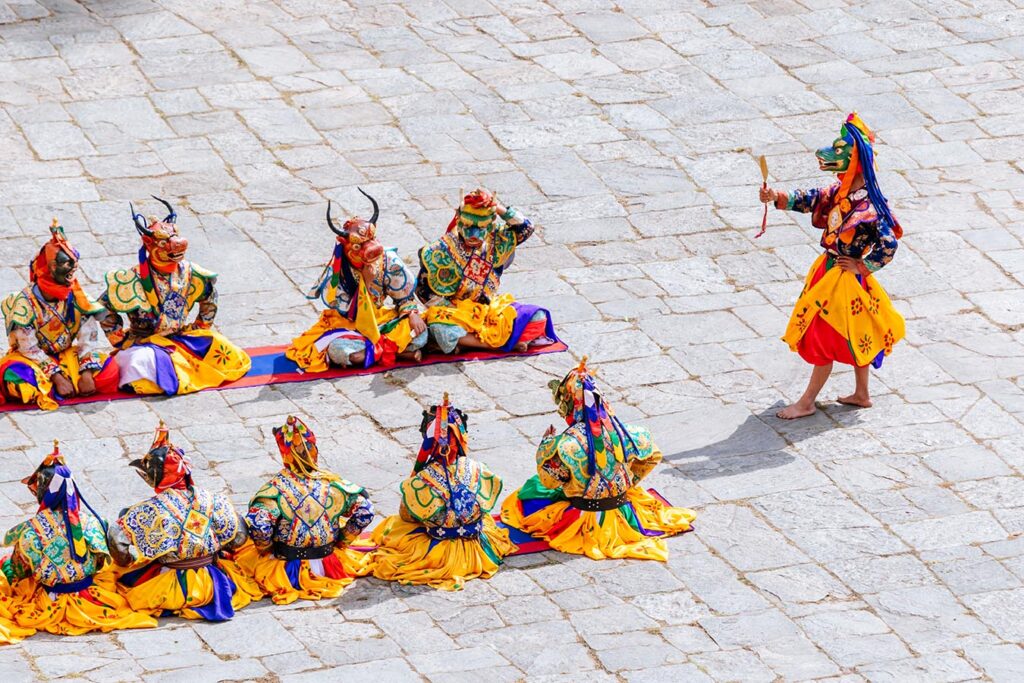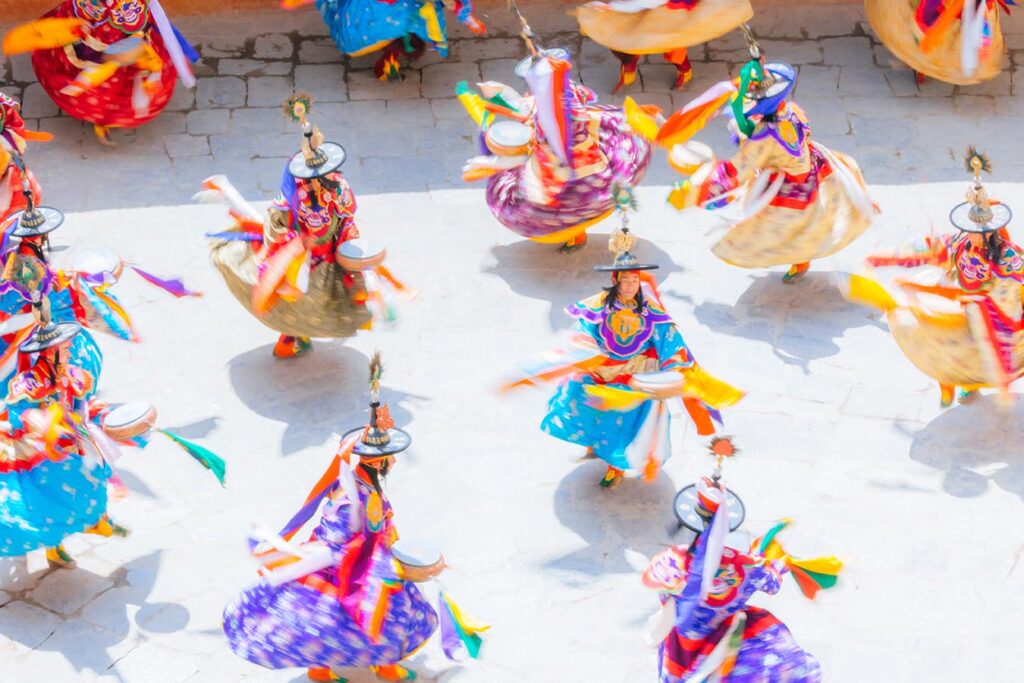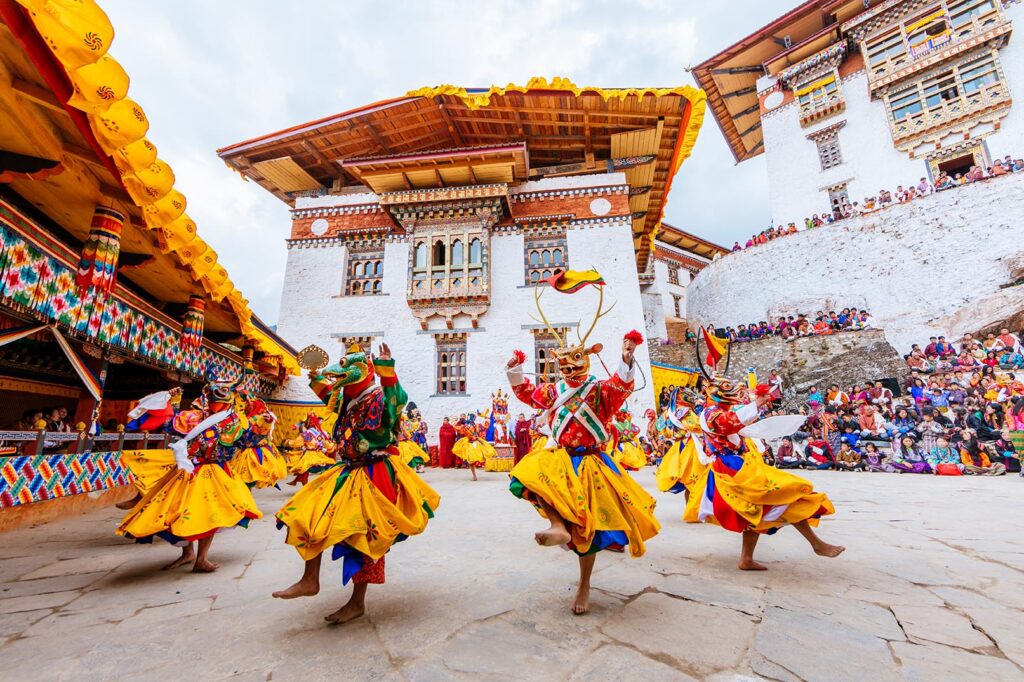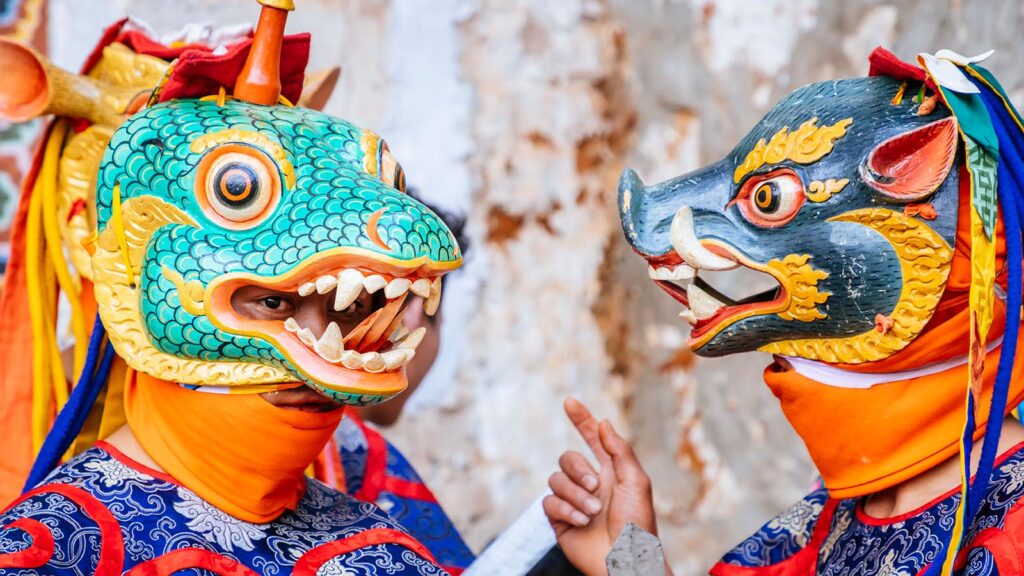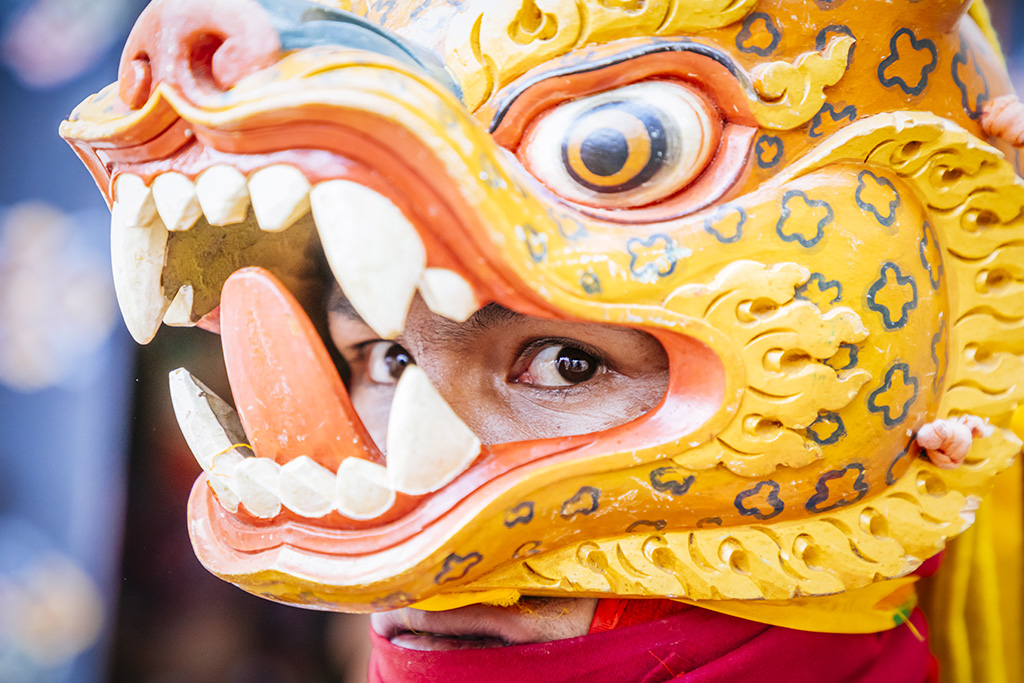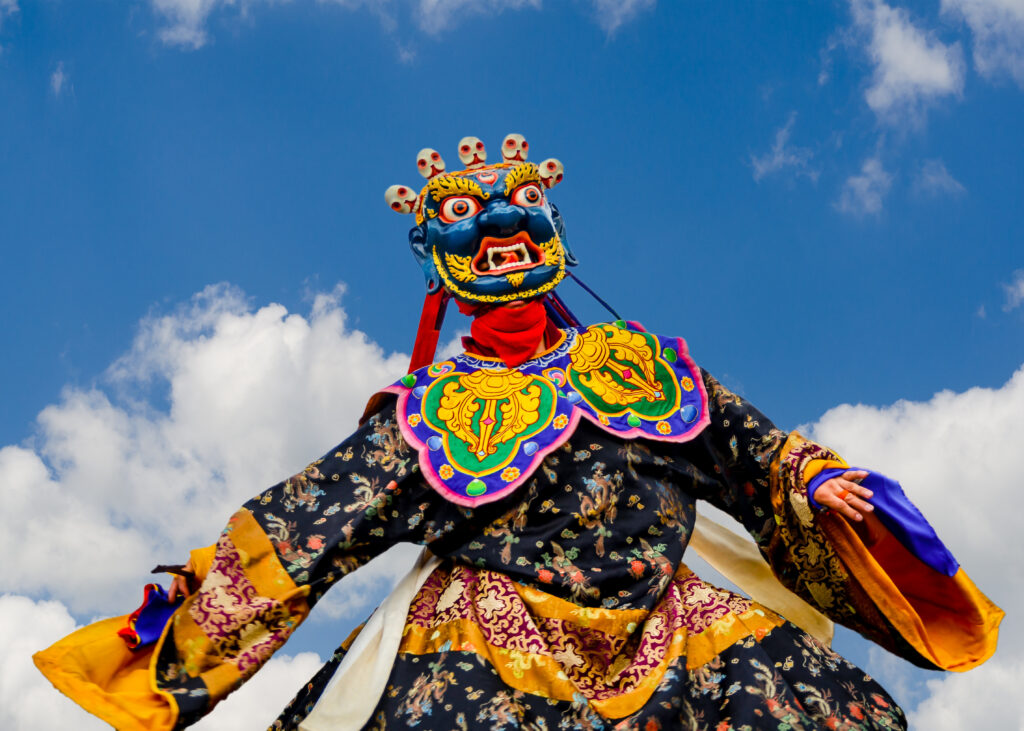Day 01: Arrive in Paro and travel to Thimphu
- Altitude in Paro: 2,300m
- Altitude in Thimphu: 2,400m
- Distance: 55km
- Estimated travel time: 1.30hrs
Welcome to Bhutan, the last Shangri La on Earth! Famed for its unrivaled landscape, Bhutan makes sure to impress any travelers from the first moment with the spectacular view of Himalayan snowcapped mountains from above. So, the first thing to do is to look out of the window as your plane approaches Paro airport to catch this view. Our representative will be there to warmly welcome you.
We will then drive to Thimphu – Bhutan’s capital. On the way, we will pay a visit to Tachogang Lhakhang (Temple of The Excellent Horse), an impressive temple erected by the famous Bhutanese bridge builder Thangtong Gyalpo (1385-1464).
The city of Thimphu itself is undeniably charming with a juxtaposition of historic landmarks and modern infrastructures. First, we will head to the National Memorial Chorten. The holy chorten is dedicated to world peace and prosperity, and later became a memorial to the Late King His Majesty Jigme Dorji Wangchuck. This is one of the most iconic structures of Thimphu.
Then we will visit Buddha Point (Buddha Dordenma Statue), the tallest statue in the country at a height of 51.5m. The remarkable statue, with the 125,000 smaller Buddha statues inside, emanates an aura of peace and happiness to the world.
The last attraction to see today is the astonishing Tashichho Dzong (Fortress of The Glorious Religion). The massive complex, first built in 1216 A.D, is located next to the banks of Wang Chhu River. The picture of the dzong standing next to Wang Chhu River is very eye-catching, especially with the lovely surrounding gardens. The sight of the flag changing at this place is also captivating, and you can catch it at 5pm!
In the late afternoon, we can see the vibrant life in Thimphu while walking around the main street Norzin Lam, where all kinds of items can be found, from souvenirs, woolen clothes to local alcohol. Thimphu’s nightclubs are also worth visiting for their great music and tasty snacks.
We will stay tonight at the hotel in Thimphu.
Day 02: Thimphu to Gangtey
- Altitude in Gangtey: 2,900m
- Distance: 160km
- Estimated travel time: 6hrs
From Thimphu, we will drive to Gangtey valley (or Phobijkha valley). We will stop at Dochula Pass at 3,050m, to enjoy the breathtaking mountain view it offers. You will be rewarded with wonderful panoramic views of the eastern Himalayan mountain ranges, with the chortens running along the hillside and the snowcapped mountain backdrop.
Once we reach Gangtey, we will follow the Gangtey Nature Trail to see the charming stunning landscape of the valley. Starting from the small hilltop overlooking Gangtey Goemba, we will descend to exquisite flower pastures and to Semchubara village. The trail will then pass through lush forest of blue pines to a valley viewpoint and finish at the small Khewang Lhakhang (Khewang temple).
Overnight at the hotel in Gangtey.
Day 03: Gangtey Tshechu Festival
The Gangtey Tshechu Festival is a three-day celebration that occurs within the expansive courtyard of the Gangtey Goemba monastery, situated atop a hill that overlooks the stunning Phobjikha valley.
This remarkable monastery was established in 1613, as a result of the 15th-century prediction made by Pema Lingpa. The monastery is a primary site for the religious tradition founded on Pema Lingpa’s revelations and is one of the two principal centers of the Nyingmapa school of Buddhism in the country.
The festival date is determined according to the lunar calendar, so the exact dates may vary slightly year by year. Generally, the Gangtey Tshechu Festival takes place in September or October, after the harvest season. This vibrant festival features traditional mask dances, religious ceremonies, and community gatherings, making it a true celebration of Bhutanese culture.
During the festival, you will witness sacred masked dances, local folk songs, and dances presented by monks and local people. These dances focus on three themes – dances with moral stories, dances that purify and protect people from destructive spirits, and dances that celebrate the triumph of Buddhism and Guru Rinpoche. The Bhutanese believe that these dances provide many blessings, luck, and prosperity, and are a path to enlightenment for anyone lucky enough to witness them.
Being part of this unique and colorful celebration is undoubtedly the best way to learn about Bhutanese traditions!
Below are the dances throughout the three days of Gangtey Tshechu Festival and the meaning behind each mesmerizing performance.
Day One: Pema Lingpa
On the first day of the festival, you will have a chance to enjoy: Atsara – Dance of The Clowns; Sa Cha Cham – Ground Breaking Ceremony Dance; Nuenlayma Cham – Dance of The Old Lady; Jug Ging Cham – Stick Dance of the Dorling Tradition; Dri Ging Cham – The Sword Dance; Nga Ging Cham – The Drum Dance; Tsham Chey Zhi Dra – Demarcation of Peaceful and Wrathful; Pa Cham – The Dance of the Heroes; TshoLing Cham – The Dance Enacts Sacred War between The Gods and Demons + Ging Chen Cham – The Dance Enacts Sacred War between the Gods and Demons.
Here are some of the highlights of Day one’s performances:
- Pa Cham – The Dance of The Heroes
Pa Cham was introduced in the 15th century by Tertoen Pema Lingpa. According to legend, Pema Lingpa had a mystical experience where he traveled to Zangdog Pelri, the copper-colored mountain, and saw Guru Rinpoche seated in the center of a beautiful mandala of rainbows. Guru Rinpoche was surrounded by an assembly of sages, heroes, heroines, tutelary deities and dakas and dakinis (spiritual, non-human beings). They were dancing in the forms of emanations of peaceful and terrifying deities and singing harmoniously together. Pema Lingpa then introduced the Pa Cham dance to lead those who witnessed it into the presence of Guru Rinpoche.
This is a peaceful form of dance performed for the benefit of sentient beings. Unlike other traditional dances that use masks, the dancers in Pa Cham don’t wear any masks. They wear yellow knee-length skirts and golden, five-pointed crowns on their heads. Each of the five faces of the crowns represents one of the five meditational Buddha families of tantric Buddhism. The dancers represent long-haired dakinis, and long strands of black thread hang below their crowns. They perform the dance barefoot while carrying a small bell and a small drum.
- Tsholing Cham – The Dance enacts Sacred War between the Gods and Demons
Ging Tsholing Chham, or the Wrath War Dance, is an absolutely captivating and powerful combination of two dances – Ging Chham and Tsholing Chham.
In the 15th century, Pema Lingpa had a powerful vision of the Ging Tsholing Dance, which he introduced to the people.
During the construction of the Samye monastery in Tibet, King Thrisong Detsen encountered fierce opposition from evil spirits. However, Guru Rinpoche, who possessed supernatural powers, took the form of Ging to vanquish and subdue these spirits. The dance portrays Zangdo Pelri, the paradise of Guru Rinpoche, with enlightened sages of India and Tibet seated on his right and scholars on his left. The intermediate areas showcase the 108 treasure discoverers, his incarnations, and his 25 disciples, including King Thrisong Detsen.
Tsholing Chham is a powerful dance performed by the Tsholings, who are revered as terrifying deities that safeguard the religion. The dance commences with the forceful destruction of an effigy, representing the evil spirits, enclosed inside a black box. Following this, the Tsholing dancers, adorned in long, vibrant dresses and frightening masks, are driven away by the Ging dancers.
- Ging Chen Cham – The Dance enacts Sacred War between the Gods and Demons
The inner dance Ging Tsholing, known as the Ging dance, is performed by a group of spiritual heroes, deities, and dakinis in their peaceful and wrathful forms. The Ging dancers, dressed in imitation tiger skins, and masks with a flag atop, celebrate their triumph over evil, beating their drums in a victory dance. The dance signifies the firm victory of good over evil
Day Two: Karma Lingpa
On the second day of the festival, you will have: Shinjey Yab Yum Cham – The Dance of Yamantaka Make and Female; Shazam Cham – Dance of the Four Stags; Kye Cham – Stick Dance of Farewell; Peling Nga Cham – The Three Ging Dances of Pema Lingpa; Raksha Go Cham – Ox-headed Dance introduced by Terton Karma Lingpa; Khandro Nga – Dance of the Five Dakinis.
Day two is also full of significant performances:
- Shazam Cham – Dance of the Four Stags
Shazam Cham’s origin dates back to the 8th century. It was first performed by Namkhai Nyingpo, and it re-enacts a famous event in the life of Guru Rinpoche. It is believed that Guru Rinpoche had defeated the King of the Wind, Sabdag, in a contest. Sabdag was causing much trouble and unhappiness among the people, but Guru Rinpoche was able to subdue him. To celebrate his victory, Guru Rinpoche rode a great stag around the world to bring peace and happiness.
The dance is not only a subjugation dance to ward off evil influences but is also believed to have a positive impact on those who witness its performance. During the performance, bare-chested dancers wear stag masks, cloud collars, and knee-length silk skirts.
- Peling Nga Cham – The Three Ging Dances of Pema Lingpa
Peling Nga Cham, also known as Drametse Ngacham is a famous mask dance performed across Bhutan during festivals to honour Guru Rinpoche. There are various versions regarding the origin of the dance, but it is generally believed that Khedrup Kuenga Gyeltshen introduced it in the Ogyen Thechog Choling monastery during the 16th century.
The traditional dance from Bhutan is performed by sixteen male dancers wearing yellow knee-length skirts and masks of various animals and birds, including the twelve animals of the Bhutanese horoscope. The dancers carry a large hand drum in the left hand and a drumstick in the right. The dance is performed in two sequences: a calm version and a wrathful one.
The purpose of the dance is to help people become familiar with the appearance of the animals they are believed to encounter in the intermediate state after death. The significance of the Drametse Ngacham is multi-faceted, as its performance is believed to help the Mahayana teachings flourish, bring peace to sentient beings, prevent calamities and internal strife, and bring good fortune to the country.
In 2005, UNESCO recognized the Drametse Ngacham as a Masterpiece of the World Intangible Heritage.
- Raksha Go Cham – Ox-headed Dance introduced by Terton Karma Lingpa;
The Raksha Mangcham is an impressive dance form introduced by Tertoen Karma Lingpa. The dance is based on the Bardo Thoedrol (Book of the Dead), a text that was hidden by Guru Rinpoche in a cave and later rediscovered by Karma Lingpa in the 14th century. This dance is closely associated with the soul of a person after death. According to beliefs, when a person dies, his/her soul enters an intermediate state called bardo, which exists between death and rebirth. In that stage, the Buddha appears in numerous peaceful and wrathful forms to guide and liberate the confused soul to eternal peace. It is said that these appearances of the Buddha are recognized as one’s saviors by those who believed in the Triple Gem while living in the earthly world as human beings.
The whole dance is a powerful theatrical performance set in a court of justice. The Lord of Death takes on the supreme role of passing judgment based on one’s deeds, and the most trusted Raksha Lango, the Ox-headed dancer, acts as the Minister of Justice, following the principles of the cause and effect relationship of good and bad deeds with strict obedience. Other loyal dancers, including Phag Gochen, the Wild hog-headed dancer, Chung Gochen, the Garuda-headed dancer, Singye Gochen, the lion-headed dancer, Domgyi Gochen, the bear-headed dancer, Drulgyi Gochen, the snake-headed dancer, and Trelgyi Gochen, the monkey-headed dancer, also present at the court.
Upon closer observation, one can easily follow the dance of the intermediate state and witness the judgments passed by the Lord of Death on Digchen Nyalwabum, a sinner, and on Khimdag Palkyed, a virtuous householder.
Day Three- Eight Manifestation of Guru Rinpoche
On this day, you can witness: Chung Zam Cham – Dance of Garuda; Tsham Choe; Jin Baap Cham; Zhana Nga Cham – Black Hat Drum Dance; Durdag Cham – Dance of the Lords of the Cremation Grounds; Tung Ngam Cham – Dance of Terrifying Deities with religious instruments. – booked: Dance of Terrifying Deities; Ging Cham – The Dance Enacts Sacred War between the Gods and Demons + Tsholing Cham – The Dance Enacts Sacred War between the Gods and Demons: book: Ging Tsholing – Dance of the Ging and Tsholing; Guru Tshen Gye Cham – Dance of the Eight Manifestations of Guru Rinpoche.
Day three’s program is filled with some of the most mesmerizing dances:
- Chung Zam Cham – Dance of Garuda
Chung Zam Cham portrays a legend from the 8th century. According to the legend, the soil-owning spirit and its evil followers spread diseases among the sentient beings, causing them immense suffering. To rescue the six classes of living beings from this unfortunate situation, Guru Padmasambhava transformed into the mythical bird, Garuda, and defeated the harmful spirits, bringing back peace and comfort.
- Zhana Nga Cham – Black Hat Drum Dance
Zhana Nga Cham, also known as the Black Hat Drum Dance, is a traditional dance that symbolizes the triumph of good over evil. The dance originated from the Vajrayana tradition, where the masters used their skills to overcome afflictions that hindered their progress in Buddhism.
During the performance, the dancers wear black hats, felt boots, and colorful long brocade garments while beating their drums to proclaim victory over evil spirits. The sound of the drums represents religion and the subtle form of Buddha’s teachings. Zhana Nga Cham is usually performed during significant events, such as when great works are planned. For instance, it was performed when the Glorious Zhabdrung Ngawang Namgyal consolidated the country.
The dance is believed to pacify the elements of earth, water, fire, and air, making them fertile and supportive of initiatives.
- Durdag Cham – Dance of the Lords of the Cremation Grounds
Durthroe Dagmo Chezi Cham, also known as Durdag Cham or simply Durdag, has a special meaning. The dance itself is a fascinating depiction of how a person who believes in religion and desires to spread its teachings can attain a higher state of life by following the white path with single-minded devotion. The lords of the cremation grounds take vows to protect the Dharma teaching and its practitioners. They guard the Mandalas of the Tantric Deities and protect them by rendering the evil forces powerless or destroying them. The spirits that are not destroyed are then offered to the higher deities.
But that’s not all. During this performance, four dancers wear short white skirts, white gloves, white boots, and white skull masks. It’s a mesmerizing sight to behold! Witnessing the cham can serve as a powerful reminder of the importance of believing in religion and practicing the Dharma.
- Tung Ngam Cham – Dance of terrifying Deities
Tung Ngam Cham is where you will learn about a different form of Guru Rinpoche.
Legend has it that Sutrayana and Vajrayana vehicles are the ultimate refuge for all sentient beings. However, there are some beings, both human and non-human, that cause harm or obstacles to the transmission of teachings. To subdue these beings that do not submit to peaceful means, Guru Rinpoche took on wrathful forms to overpower them.
This is depicted in the Tung Ngam dance, a mesmerizing performance where one of the dancers represents Dorje Dragpo, the terrifying form Guru Rinpoche assumed to subdue enemies of the doctrine. The performers are representations of the deities of Gongdue, also known as the Embodiment of Realization. They wear beautiful brocade robes and boots, but with terrifying masks.
- Ging Cham – The Dance enacts Sacred War between the Gods and Demons
The Ging Tsholing Cham, also known as the Wrath War Dance, is a captivating combination of two dances – Ging Cham and Tsholing Cham.
In the 15th century, Pema Lingpa had a vision of the Ging Tsholing Dance and introduced it to the people.
During the construction of the Samye monastery in Tibet, an essential part of establishing the teachings of Buddha, King Thrisong Detsen faced hindrances from evil spirits. Guru Rinpoche, using his supernatural powers, manifested himself in the form of Ging to combat and subdue these spirits. The dance portrays Zangdo Pelri, the paradise of Guru Rinpoche, with enlightened sages of India and Tibet seated on his right and scholars on his left. The intermediate areas feature the 108 treasure discoverers, his incarnations, and his 25 disciples, including King Thrisong Detsen.
The inner dance, known as the Ging dance, is performed by an assembly of spiritual heroes, deities, and dakinis in their peaceful and wrathful forms.
- Tsholing Cham – The Dance enacts Sacred War between the Gods and Demons
The outer dance called Tsholing is performed by the Tsholings, terrifying deities seen as protectors of the religion. The performance begins with the destruction of an effigy in a black box, which symbolizes the evil spirits. After this, the Tsholing dancers, who wear long, colorful dresses and terrifying masks, are chased away by the Ging dancers. The Ging dancers, who wear imitation tiger skins and terrifying masks with a flag on top, perform a victory dance while beating their drums. The dance represents the triumph of good over evil.
- Guru Tshengye Cham – The Dance of Eight Manifestations of Guru Rinpoche
Guru Rinpoche is known to have taken many miraculous forms to ward off evils and benefit the world, especially the regions of Tibet, Sikkim, and Bhutan. In the dance of Guru Tshengye, he appeared in the following forms:
- Guru Tshokye Dorji: When Guru Rinpoche was miraculously born from Lake Dhanakosha as the son of King Indra Bodhi, he came to be known by this name.
- Guru Shakya Singye: When Guru Rinpoche left the palace to seek the path of Dharma in the cave of Maratika, he was known by this name.
- Guru Loden Chogsed: He was known by this name when he had mastered all the instructions of the Sutras and Tantras in the sacred places of India.
- Guru Pema Sambhava: When Guru Rinpoche took Lhacham Mendarava as his mystical consort, her father, the King of Zahor, became offended and set him on fire. However, the fire miraculously transformed into a lake of lotuses. As a result of this miraculous feat, Guru Rinpoche became known by this name.
- Guru Pema Gyalpo: After returning to the domain of Ogyen, Guru Rinpoche and his parents were targeted for assassination by the evil ministers. However, they were ultimately defeated and converted to Buddhism. As a result of this accomplishment, Guru Rinpoche was given his name.
- Guru Nima Oezer: He had this name when Guru Rinpoche traveled through the eight great charnel grounds, including the legendary Sewa Tshal; he gave teachings to dakinis and tamed evil forces.
- Guru Singye Dradrog: When Guru Rinpoche overcame opposition to the Dharma in Bodh Gaya, he was known by this name due to his miraculous feats.
- Guru Dorje Drolo: When Guru Rinpoche flew on the back of a tigress from Singye Dzong in Kurtoe to Tagtshang in Paro, concealing sacred objects and prevailing over evil forces, he was known by this name.
The Thongdrel revealing is the most highly anticipated event of Tshechu, and it takes place on the last day of the festival. During this event, the monks unveil a gigantic silk Thangkha, known as the Guru Throngdel. The Thongdrel is impressively large, covering the face of an entire building. It is a sacred scroll that is only displayed for a few hours before sunrise and brought down before the sun touches it. Legend has it that viewing the Thongdrel can cleanse one’s sins.
You will stay overnight at the hotel in Gangtey.
Day 04: Gangtey to Punakha
- Altitude in Punakha: 1,300m
- Distance: 87km
- Estimated travel time: 3hrs
After breakfast, we will spend the first half of the day continuing to join Gangtey Tshechu. You will be able to see different performances today. The atmosphere during the days of the Tshechu is always vibrant and filled with happiness.
We will go to Punakha after lunch, with sight en-route and stops for refreshments. Punakha is the old capital of Bhutan, a city of history, which has witnessed the most important moments of Bhutan’s history.
We will stay overnight at the hotel in Punakha.
Day 05: Punakha sightseeing
We will visit Sangchhen Dorji Lhuendrup Lhakhang Nunnery after breakfast. The striking temple is also a nunnery, sitting on a cliff overlooking the staggering valleys of Punakha and Wangduephodrang. The complex also consists of a permanent higher learning and meditation centre for the nuns.
Then we will explore the lavishing structure of Punakha Dzong (Palace of Great Happiness). It was built in 1637 as the second dzong erected in the country. The seat of Bhutan government was located here until early 1950s, and the wedding of the King Jigme Khesar Namgyel Wangchuck to Jetsun Pema was also held at the dzong.
Passing the dzong, we will see Pho Chhu suspension bridge – the longest of its kind in Bhutan. The 160m bridge is decorated with colourful prayer flags, and from the bridge, you will have the view of Punakha Dzong and the breathtaking landscape of Pho Chhu valley.
Later, we will hike through lovely rice fields and pine trees to Khamsum Yuelley Namgyal Chorten at an altitude of 1,500m. The short walk will only be about 1 hour. The chorten is well-known for its unique structure, and is one of the best examples of Bhutan’s architectural and artistic traditions. Erected by Her Majesty the Queen Mother, the chorten is dedicated to the wellbeing of the whole country as well as for the long life of our beloved King. Because of its location on the ridge, this is where you can have the best view of Punakha valley’s picturesque landscape.
We will stay overnight at the hotel in Punakha.
Day 06: Punakha to Paro
- Distance: 125km
- Estimated travel time: 4hrs
Today we will drive back to Paro. Along the way, we will visit Chimi Lhakhang (Temple of Fertility), which we can reach within 25 minutes, after a lovely walk across green hillock fields and farm lands of Lobesa Village. This temple is popular since childless women can go here to pray and to receive a wang (blessing or empowerment).
In the afternoon, we will have time to explore the massive complex of Paro Rinpung Dzong (Fortress of The Heap of Jewels). The great dzong was built in 1644 on the foundation of a monastery erected by Guru Rinpoche. The massive dzong with its towering white walls can actually be seen from anywhere in the town. Today the place houses both the monastic body and district government offices, including the local courts.
Afterwards, we will learn more about life in Bhutan by visiting the National Museum of Bhutan (or Ta Dzong). The building became the National Museum after the war, and it is now a favorite attraction for travelers. You will find here extensive collections, from thangkas, festival masks for Tshechu dances, to assortments of weapons and textile.
We will stay overnight at the hotel in Paro.
Day 07: Paro sightseeing
There is a local saying about the sacred Taktsang Monastery (or ‘Tiger’s Nest’): “If you have never been to Tiger Cave Temple, your trip to Bhutan is not complete.” The monastery is one of the holiest sites in Bhutan, and every Bhutanese is expected to complete a pilgrimage to the Tiger’s Nest once in their life. The walk to the temple is 4.5km one way, with an elevation gain of around 900m. Along the trail, we will stop for you to enjoy and take photos of the incredible landscape of Paro valley, with lush green forests and endless mountain ranges in the distance.
After the hike to the Tiger’s Nest, we will continue by visiting Kyichu Lhakhang – one of the country’s oldest and most prominent temples. It is one of the 108 temples built by the Tibetan King Songtsen Gampo in the 7th century, marking the introduction of Buddhism in the Himalayas. The sight of elderly pilgrims shuffling around the temple and spinning its prayer wheels makes this one of the most charming spots in the valley.
In the late afternoon, we will have a special dinner with a local family, in a traditional farm house. You will love spending time with the friendliest people, chatting over authentic Bhutanese dishes.
You will stay at the hotel in Paro for the last night of the trip.
Day 08: Depart Paro
After breakfast at the hotel, your guide will accompany you to the airport for flight to your onward destination. Tashi Delek (goodbye and good luck) and we hope to see you again!


